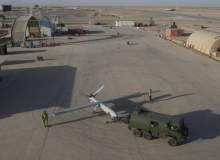
UK Defence Secretary Michael Fallon announced the beginning of Watchkeeper operations on a visit to Kabul alongside the Chief of the Defence Staff, General Sir Nicholas Houghton. Senior officials also visited Camp Bastion – now the only UK-controlled base in Afghanistan – to meet personnel and see Watchkeeper conduct missions.
"Watchkeeper is the first Unmanned Air System developed and built in the UK to become operational and will be a significant surveillance and reconnaissance capability for the Army for years to come," said Fallon.
"There is no doubt that it will prove to be a battle-winning technology," he added.

US Tariffs are shifting - will you react or anticipate?
Don’t let policy changes catch you off guard. Stay proactive with real-time data and expert analysis.
By GlobalDataVideo released by the MOD shows soldiers at Camp Bastion unpacking and assembling Watchkeeper from a standard shipping container. One advantage of the new UAS is that it can be transported by air, land and sea in a protected international standard container (ISO) and, as the video shows, assembly and disassembly is fast. Watchkeeper can even take off and land from rough airstrips if necessary.
General Houghton, the head of the UK armed forces, said he was "delighted" to see Watchkeeper in operational use when he visited troops earlier this week.
"The enhanced real-time situational awareness Watchkeeper provides means that our local understanding is greater, our tactical decisions better informed and that, ultimately, personnel on the ground are safer," he said.
Engineers have developed a human-like skin for aircraft which can detect damage and sense the world .
British troops will be able to take advantage of Watchkeeper’s high-definition electro-optical camera, which can detect and track targets during the day. It also features an infra-red camera for night operations and an advanced Laser Sub System which can mark targets for precision weapons. Additional surveillance capabilities are provided by a synthetic aperture radar, which accurately produces ground mapping images.
Watchkeeper can take off and land autonomously, significantly reducing training needs and operational burden for the pilots. According to one pilot, the video and images which are produced by the UAS are like what you see during police chases on TV, "the main differences are the videos and pictures are much higher resolution".
Seeing Watchkeeper finally make it to the frontline will be a big relief for the Ministry of Defence. The MOD chose the Watchkeeper – a design based on the Israeli Hermes 450 UAV – a decade ago and it was expected to be fielded in 2010, but development work and certification issues have caused substantial delays. The aircraft has recently been undergoing extensive flight trials at West Wales Airport, Parc Aberporth.
As of June this year, 30 Watchkeeper UAS have been built for the British Army and a further 24 are expected. When Camp Bastion is finally handed over to Afghan security forces, Watchkeeper will return to Wiltshire where the Royal Artillery will continue its training on the system. The next generation UAS is expected to be in service with the British Army until 2040.
Follow Grant Turnbull on Google+


.gif)

